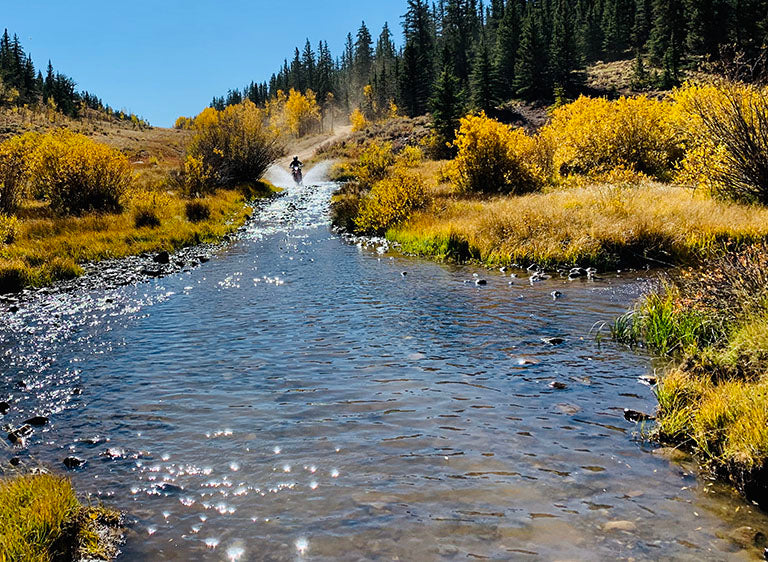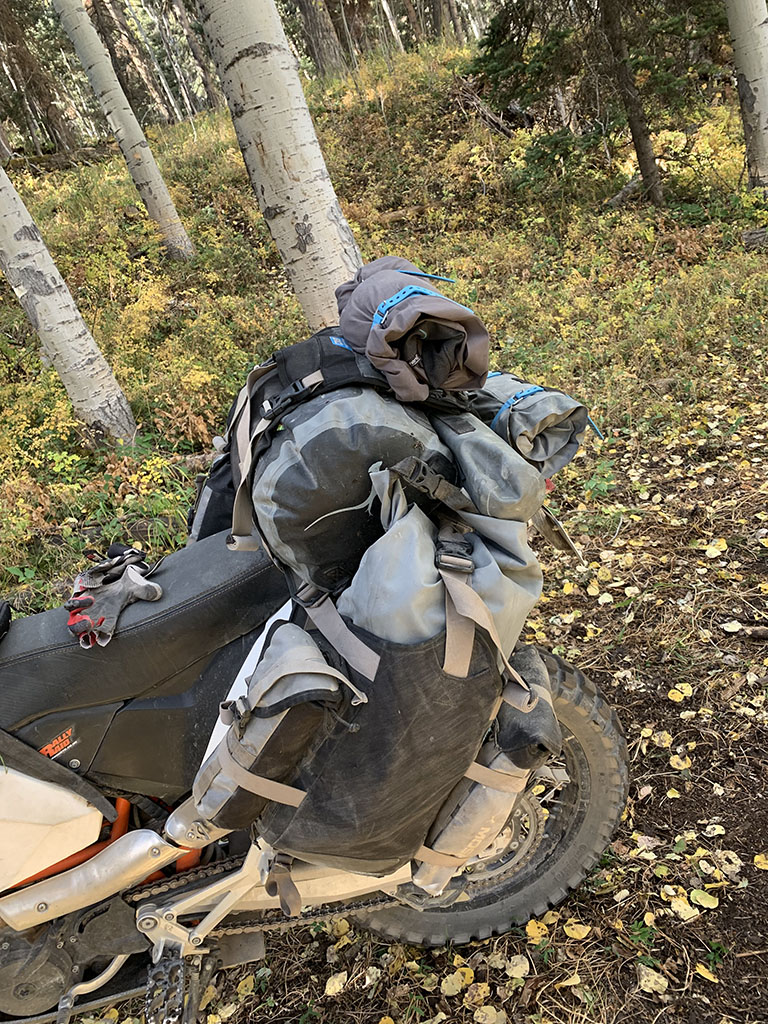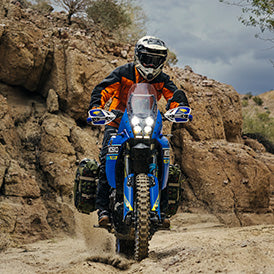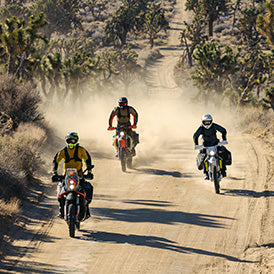Your Cart is Empty
Some countries are currently experiencing out of stock errors. Check back soon for updates.
Free Shipping On Orders Over $200 USD
Some countries are currently experiencing out of stock errors. Check back soon for updates.
Free Shipping On Orders Over $200 USD
Luggage
Apparel
The Mosko Blog
Moto Packing List
April 12, 2022

Sometimes we get questions about what to take on an Adventure Motorcycle trip and how to pack the bike. There's no one-size-fits-all answer for that, because every trip is different. For example I have 4 different camping kits that I use on three different bikes with at least five different luggage setups. That said, there's some stuff that comes on every trip no matter what.
In this post I’ll share exactly what Ash and I took on the Colorado Backcountry Discovery Route last year. When we got home and unpacked our bags, we wrote down every single thing that came out. I think this is a reasonable starting point for someone building a motorcycle camping kit for the first time.


On this trip, Ash was riding a Honda 450L with a Reckless 40, and I was on a KTM 690 with a Reckless 80. Between us we shared things like a cook stove, cook pot, and tent, but we each took our own food. We stayed in a hotel one night and camped the rest. The Colorado Backcountry Discovery Route is mostly fast dirt/pavement with a few technical bits getting over various mountain passes.

At the end of the post, I’ll share some general packing tips from many trips on many continents over many years. After that I’ll share a video of how I packed for a very different kind of trip in Africa, where I didn’t know what kind of bike I’d be riding until I landed, found one, and bought it. I'll also post a video that outlines a scaled-down overnight packing scenario for camping off a dirt bike.
Here are the lists from the Colorado BDR.
Ashley
(Mosko Reckless 40 with a Stinger 22 Tailbag and Pico Tank Bag on a Honda 450L)

Apparel
Mosko Basilisk Jacket
Mosko Basilisk Pant
Mosko Imbricate Base Layer
Mosko Signal Jersey
Dainese Armor Harness (chest, back, shoulders, elbows)
Forcefield Limb Tubes (knees)
Klim Gloves (desert glove + waterproof glove)
Bags
Mosko Reckless 40 w/ Stinger 22L as tail bag
2 Sm Mosko MOLLE Pouches
Mosko Pico w/ cell phone case
USWE pack
In Bags
X2 1L MSR Bottles
Multi-tool
Pocket Knife
Stove + 1 Person Cooking Kit
Hydroflask Mug (fits in 2L MOLLE)
Snowpeak Spork
Dry Sak (trash)
Dry Sak (dirty laundry)
Goal Zero Crush Light
Goal Zero Venture 70
Dakine Soft Lunch Box
Marmot Phase Sleeping Bag
Rumpl Pillow
Poncho
Beanie
inReach
Sleeping Pad
X2 Socks
X3 Athletic Shorts
Mission Workshop Merino Wool Hoodie
Arcteryx Jacket (NO HOOD!!!)
Camp Socks
Camp down slipper OR New Balance (depending on temps)
X2 Sports Bra
Lululemon short sleeve base layer
Deluge? (Pant and Jacket!)
Arcteryx Delaney Legging
First Aid Kit (in 2L MOLLE)
Custom Molded Earplugs
Chapstick
Listerine Strips
Grass Fed Jerky
Marcona Almonds
PB Packets
Oatmeal
Hard Cheese
Salami
White Rice/Farro Packets
Gnocchi 3 min. cook time
Hot Sauce
Pistachios (cajun!)
Variety of non GMO, gluten free bars (RX, Kates Real Food)
Vegetarian/grassfed Chicken/Beef packets (flat packs!)
Gluten Free Tortillas
True Lemon/Lime/Grapefruit/Orange
Fat Fuel Coffee Packets
Inhaler
Simple facewipes
toothbrush
floss
lotion/serum
headlamp
Deuce poop trowel
TP
Hydrocortisone
Neosporin
Rotos eyedrops
Pete
(Mosko Reckless 80 and a Nomad Tank Bag on a KTM 690 Enduro R)

Apparel
Mosko Basilisk Pant
Mosko Basilisk Jacket
Mosko Signal Jersey
Forcefield ADV Harness Chest/Back/Elbow
Leatt 3DF 6.0 Elbow pads
Forcefield Pro Tube Knee pads
Mosko Imbricate base layer
Revit Dominator GTX Waterproof Gloves
Klim Mojave Moto Gloves
Klim Krios Helmet
Sidi ADV Gore Boots
Compression shorts
Bags
Mosko Reckless 80
2 Sm Mosko Molle Pouches
1 Lg Mosko Molle Pouch
Mosko Nomad Tank Bag
Mosko Fatty Tool Roll
In Bags
Side pannier 1 –
Marmot Tungsten UL 3p Tent in compression sack
Thermarest Neoair sleeping pad
Marmot Phase 20d sleeping bag in compression sack
Thermarest pillowcase
Dakine food bag
Insulated poncho/blanket in compression sack, MSR ‘Honcho Poncho’ (cold weather trips only)
Side pannier 2 –
Camp stove (Ash’s bike)
Cook pot (Ash’s bike)
Stove fuel (Ash’s bike)
Eating utensil
A-Lite Camp chair
Lighter
Food
Stinger 22 Tailbag –
1 Pants
2 Boxers
1 Tee
1 Thin heated/insulated jacket
1 Beanie
2 Socks
Kindle
Dop kit (incl cortisone, Advil, antacids, chapstick, zyzal, mini deet, sun lotion)
Earplugs
Patagonia long underwear
New Balance Minimus packable shoes
2 sm molle pouches –
20 oz Thermos (coffee)
20 oz Water bottle (gatorade)
Rear Harness –
2L MSR Dromedary (water)
Lg MOLLE –
Toilet paper
Mosko Deuce Poop trowel
MSR AutoFlow water filter
Nomad Tank Bag –
1.5l hydration reservoir
Goal zero venture 70 battery pack
MOLLE cell phone case
Gerber center drive & bits
Garmin inreach 66i
Pen
Spare batteries for headlamp aaa
Petzl headlamp
iPhone cable
Kindle/inreach charge cable
1 usb wall plug
Spare key
iPhone dongle (x2)
Mosko stickers
Business cards
Battery tender to USB adapter
Spare cig lighter
Sunglasses
Custom molded in-ear headphones
Rain cover
Fatty Tool Roll –
Tow rope
Zip ties
Air pump (hand)
Air gauge
Spare front tube light duty
Spare rear tube light duty
Spare Fuses
Tube patches, scrubber, glue
Electrical tape
Metric open ended wrenches 8-13
Ktm t-handle and sockets and torx
Metric hex keys
Ktm tire nut wrench
Two trail tire irons
Open ended adjustable wrench
screwdriver reversible
Loctite
Bailing wire
Mini vice grips
Valve stem removal and tapping tool
JB quick (in toothpaste holder)
Mini chain lube
Extra clutch plates
Spare fuel pump
Spare valve rockers
Navigation –
iPhone (primary nav)
Paper maps (backup)
Inreach with maps (backup backup)
Bike –
Drivers license
Registration
Insurance
Food List –
Instant oatmeal flavored packs
Peanut butter/honey packs
Salami
Individual Cheese sticks
Flour tortillas
Peanut & Mm mix
Uncle bens 90 second rice bags
Buffalo flavor chicken creations packs
Dinty more beef stew
Corned beef hash
Dark chocolate bar
Starbucks via coffee packs
True lemon/lime/orange packs
Other –
2x voile straps for tool roll
2x voile straps for jacket
Spare drysak for garbage
Ash and I keep our packing lists on our phones, so they’re always handy when we're headed out the door. Plus that way we can easily edit them when we think of something new. Most of our riding/camping gear is stored in three large plastic containers in the garage so it's very easy to pack.

There’s lots of packing advice available online. Here are some general packing tips from us. Take what works, leave what doesn't.
- If we bought anything new – like accessories, racks, apparel, bags, electronics, skidplate, lights, etc – we try to install it long before our departure date. We enjoy tinkering with & installing new stuff as a casual evening project, but we hate doing it in a frenzy right before the trip.
- When packing, we keep the weight as forward and as low as possible. We put our lightest stuff in the rear duffle (the highest and farthest back point on the bike) and our heaviest stuff at the bottom/front of the side bags (the lowest and most forward). Tools are an exception to that, because we need access to them during the day.
- We store our liquids (water, gas) on the outside of our drybags whenever possible, either in external pockets or in MOLLE add-on bags. Something always ends up leaking, and we don't want it to soak through our clothes and/or sleeping bags.
- Instead of one large water storage container, we use multiple smaller ones. Specifically we use the 2L MSR Dromedary bags, plus a 2L hydration reservoir in our Nomad tank bags or backpacks. That way we can spread the weight around the bike, keeping it as low as possible.
- We bring a water filter so we can carry less water on the bike, as long as we’re riding somewhere that we can count on finding water. A water filter doesn't help if we’re in the desert and can't find a spring.
- We pack more water in the desert than the mountains. In the mountains we carry 4L apiece plus a filter. In the Great Basin or Baja we carry 6L apiece, and we never skip an opportunity to refill. If we economize, that will last through two nights of dry camping including cooking/cleaning, and two days of warm weather riding.
- Water is the heaviest thing we carry. It’s always tempting to take less, especially on a small bike. Sometimes we do at our own risk. If we breakdown or break a bone and there’s nowhere to filter – which has happened - the water goes fast.
- If we're carrying extra gas, instead of one large storage container - like a 1 gallon Rotopax - we use multiple smaller containers - like 4 1L MSR or Primus fuel bottles - to spread the weight around the bike, and because the smaller containers are easier to pack.
- If we know we'll be using our extra gas on a long stretch, we add it to the tank as soon as there's room. That reduces weight on the back of the bike for the rest of the day.'s riding.
- Tools are heavy, but it’s a pain to store them at the bottom of a pannier, because they’re difficult to access when we need them. Instead we store our tools outside our bags, usually strapped directly to the rear luggage plate or grab handles.
- It’s tempting to take less tools because of the weight, but we try not to skimp on tools. Sometimes we use the tools to fix someone else's bike, so it's not just our own bikes we think about when selecting tools.
- We always take a tow strap on every kind of trip. If we forget to bring it, that'll be the trip where we need it. A tow strap can get a broken bike to a spot where you can load it in a truck, or a spot where you can hide it out of site, or even just the last few miles to a gas station or hotel. We've towed bikes for distances of 30 miles or more, across borders and sometimes out of very sticky situations.
- We pack tent poles separate from the tent. It makes the tent much easier to pack when you separate the poles, and you can store them in a place where they're somewhat protected on the bike. A tent without poles can easily fit in a compression sack, which dramatically reduces its size.
- Backpackers dislike compression sacks because they add a small amount of weight, and they turn soft things into hard things, which are noticeably more difficult to pack. On a motorcycle trip, we feel differently. In a bike, our packable space is limited and fixed, and a few extra ounces of material hardly matters. Compression sacks make it much easier to pack bulky but light items like a sleeping bag, tent, or puffy jacket.
- When using compression sacks, we leave some items non-compressed, and we use them to fill the awkward gaps created between compression sacks in a pannier.
- We invest in modern ultralight camping gear and we always look for ways to make things smaller, lighter, warmer, and tougher. Sleeping bags, pads, tents, chairs, and stoves are continually evolving. We buy the best gear we can afford.
- We put as little in our tank bags as possible. Tank bags get messy, and big ones impede our ability to ride while standing. Passport, wallet, phone, charging cables, water, snacks, and a few other odds and ends is plenty for a tank bag. Everything else goes somewhere else on the bike.
- We carry Gamin InReach communicators. We both have one. They're great for keeping in touch if we need to split up for some reason. Plus when we're injured, bleeding, or broken in crippling pain on the side of the road it's a lifeline.
- We buy the GEOS evacuation insurance offered by Garmin along with the InReach, in addition to the standard travel insurance we buy when we're overseas (see below). There's some overlap in the coverage but we buy them both anyway. The Garmin plan only covers evacuation, whereas the travel insurance covers both evacuation and medical. The Gamin insurance is always active and it's covering us anytime we're at least 100 miles from home, whereas travel insurance is something we buy right before a specific trip to a specific country, and it only lasts for the duration of the trip.
- In 2013 after a wreck, a $250 travel policy from TravelGuard Chiartis covered $190,000 in medical and transportation costs when I was evacuated from a remote part of Honduras for surgery. For most of us, it's not realistic to think that in a foreign country where we may not speak the language and may not have cell reception, we will be able to coordinate (or even convince) jeeps, helicopters, or medical jets to land at a remote location with GPS coordinates sent by an unknown stranger (us) as guidance, to transport a bleeding and/or broken person across international borders to the nearest western-standard medical care. That's where a satellite communicator like the InReach, and the logistics professionals at GEOS or TravelGuard can help.
- When signing up for travel insurance, we don't buy the trip cancellation coverage, only medical coverage. The trip cancellation coverage is much more expensive than the medical. Travel insurance policies are priced for people going on cruise ships and guided bus tours, not riding motorcycles. That is why it's such a good deal for us moto folks. (It's worth checking to make sure that motorcycles are not specifically excluded on your policy. We've never seen it excluded, but we always check anyway).
- On international trips we carry the antibiotic and food poisoning miracle cure Ciprofloxacin (aka 'cipro'). Cipro turns a 3 day bout of puking, shitting, and fever into a single night of the same. If there are several people traveling together for a week, sometimes half the trip can get burned up waiting for sick people to recover. Cipro solves that. We take two pills immediately after the first puke, so they get absorbed before the next round of puking hits. If we wait too long to take them, sometimes we can't keep them down.
- After camping there’s always some garbage to deal with: cans, food scraps, etc. It’s handy to have a cheapo stuff sack or thin crushable bag to carry that stuff in. We dump it at our next gas stop.
- When camping in remote areas, we dig a 6” hole to poop in. Then we replace the soil after and put a rock on top if there's one handy. If it's not sufficiently covered, animals and the wind/weather will spread it around after we leave. We’ve seen many nice campsites on public land, ruined by other people's poop and paper.
- We try to pack out a little more than we packed in. It feels good to pickup trash when we see it.
For something different, here’s that video I mentioned earlier, about packing for a small bike trip in Africa.
Here’s another video of packing for a small-bike camping trip at home, with a greatly scaled-down camping kit.
Packing lists remind me of things like rules and chores: i.e. things I mostly hate. However it sure does make things easier and less stressful, to know we're not forgetting something obvious. On the other hand there's also something to be said for just tossing whatever on a bike and heading out the door. You chose :)
Hope this info helps someone!
Pete
2 Responses
Michael Cerami
August 15, 2022
Great article. Thank you!
———
Mosko Moto replied:
Thanks for checking it out, Michael!
Leave a comment
Comments will be approved before showing up.
Warranty and Crash Replacement
We never cut corners during development or manufacturing, so we stand behind our products. If one fails due to a problem with materials or workmanship, we’ll make it right.





David
February 28, 2023
After employing multiple methods of planning and packing, I still find a way to leave something behind. It could be something mildly inconvenient, or cause me stop at a store mid-trip. It has made for some interesting stories, and creative problem solving.
Thankfully, I’ve only forgotten my tent once in 35+ years of camping(yes, I know how dumb that sounds). Having a bivy cover for my sleeping bag, an old grometted poncho, and 550 cord, saved me from heavy overnight rain.
Don’t ever forget a small roll of duct tape, 550 cord, and zip ties. They don’t weigh much, and are a solution to a myriad of SNAFUs. They live in my tool bag…
:two fingers down salute:
———
Mosko Moto replied:
Hot tip, David! We completely agree – those items are ESSENTIAL. Thanks for checking out our blog!